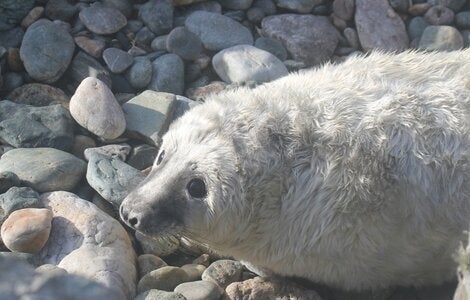The locals said they couldn't recall a storm like it. It seemed relentless, starting at dusk and continuing well into the early hours of the morning. The thunder rumbled, and forked lightning struck the sea over and over again, searing the eyes of those watching with vivid after-images. A wild wind gusted, shaking windows and rattling tiles, and several times during the night hale-stones hammered on the windows. For the few inhabitants and guests like me safely snug in the Bardsey Island Bird and Field Observatory perched out in the Irish Sea, it was just an attention-grabbing, sleep-disturbing spectacle. However, for the seals scattered around the exposed and rocky shores of this remote island, this very stormy week of October was a matter of life and death.

Bardsey Island hosts a small breeding colony of grey seals, and October is peak breeding time when ripely pregnant females haul ashore to give birth, each selecting a certain section of the rocky shore as their nursery ground. Newborn pups are white but stained at first with streaks of yellow birth fluid. Initially they are big of head, highly vocal and have scrawny little bodies. If all goes well, in just three weeks these small scraps of life swell to dumpy plumpness, their white coats falling away, grey flippers and feet emerging as the downy fluff is lost, and big black eyes soon peering from darker faces.
Waiting close by are far larger seals, their massive bulk, scarred necks and big heads complete with proud roman noses, marking them as the dominant, reproductively active bulls. They wait, with varying degrees of patience, for the moment when the females, relieved of their suckling-duties, will accept them and mate. Sometimes they push their luck and approach the mothers prematurely. They are rapidly seen off with much undulating vocalisation to which the males reply with a guttural-gurgle, which is no doubt meant to be endearing. Flipper waving is also a common deterrent. As comical as it may look, the ends of those flippers bear sharp claws. Indeed, the mothers generally keep most other seals well away from their pups. An amorous bull with its large bulk might easily squash a tiny pup.

During my visits to Bardsey, choice of nursery site has proved to be of considerable consequence, and never more so than this year. Before the storms swept in, 15 pups could be seen around the island in deep ravines and lesser alcoves. Unusually, the storms came from the south and unfortunately they coincided with very high tides. Sadly, five pups were missing after the surf retreated. Nursery grounds that were once safe in previous years proved vulnerable now as the waves reached right to the base of the low muddy cliffs, clawing far into the deep ravines. Some of the larger moulted pups may have safely gone out to sea but a couple of small crumpled white bodies washed ashore in the days following proved that others had indeed perished.
It may seem foolish of the seals to pup at this time of year, but to do so is locked in to their internal biological clocks, and has obviously served them well enough through millenia. It may also be that feeding through the plentiful spring and summer helps the mothers store enough fat to pump up their pups with milk until they look fit to burst in the autumn. This is the energy reserve that allows those youngsters who successfully moult and swim away to survive those first hidden weeks and months in the sea where they must learn to hunt and survive.

Brownie & pup.
Thanks to the work of the late and great seal biologist, Mandy McMath, we know that for several years a number of the Bardsey mothers have returned to the same small section of shore to pup. For example, 'Brownie' (so named by Mandy because instead of the more usual distinctive spots she is almost uniformly chocolate brown) favours a site on the easterly end of the island's main bay. At first glance this looks little different to the neighbouring shore. Crucially, however, Brownie has chosen a place where instead of a cliff rising behind the tide-line, a gentle slope leads up to the sheep-chewed pasture and gorse beyond. Hence, Brownie and her pup can retreat from heavy seas if necessary. On a calm low tide this 'nursery' also has a ridge of rocks forming a protected swim-training area for her white-coated offspring, and one from which Brownie can also easily exclude other seals. (Incidentally, seal-watching needs to be done with care so as not to frighten them and cause them to stampede over sharp rocks to the safety of the water.)
And the point of my Bardsey account? Well, firstly, I hope it acts as a reminder of the large marine mammals that British waters still host. In fact we are home to more than half the world's population of grey seals, as well as harbour seals and a range of dolphins and whales. Secondly, it highlights that whilst seal behaviour remains little-studied, these remarkable creatures are individuals just like other mammals. It is also perhaps a warning that increasing stormy weather - a feature of our changing climate - may have an effect on species other than our own. Latest records indicate that grey seal numbers are increasing. So whilst there may be no immediate conservation concern, that might change and the conservation of Europe's marine mammals needs now to be viewed in the context of changing planetary conditions.
Follow HSI on Facebook.
